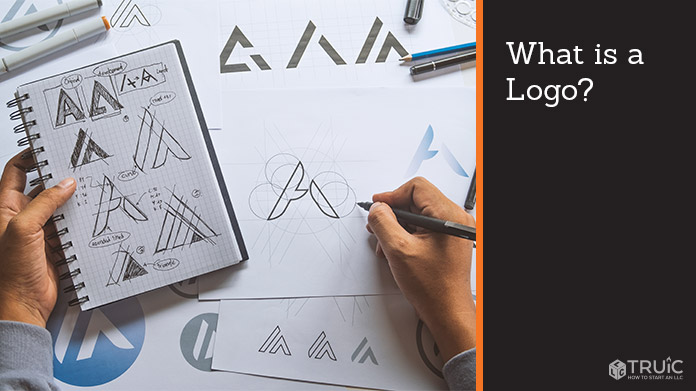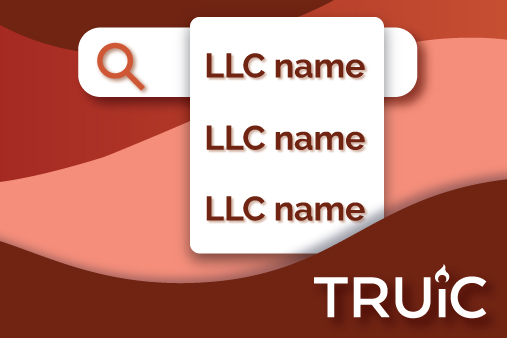What is a Logo?
The word logo is a fairly broad term, one that people might (mistakenly) use to refer to any number of designs associated with a company. When a logo can be nearly anything, it’s easy to feel overwhelmed when creating yours. We’ll look at what a logo actually is and how you can use different design metrics to make one that actually represents your company. If you are ready to create your logo now, check out our Free Logo Generator and get the ball rolling.

What Does a Logo Do?
A logo is a visual representation of your brand, and it can be made up of letters or images. All include some type of symbol, font, and colors. Some might even include a snappy tagline that sums up your work in a nutshell. The most important job for your logo to accomplish is to identify your company and be memorable.
When your logo is printed on something, it means that you’re endorsing it. Whether that’s a message, service, or object, you’re sending a signal to people about what you stand for. As long as people trust your brand, they’ll trust your business and potentially become loyal customers.
An important part of your brand is a memorable business name. If you don’t already have a business name picked out, explore our Business Name Generator to help you nail down the perfect name.
What is a Logo Made of?
There are several common elements of a logo, including typography, graphics, color, and context. Logos may stay the same, or change depending on the circumstances. Regardless, the components are all meant to work together to give your audience a comprehensive understanding of the company. And if you’re interested in learning more about How to Form an LLC, we have a page that can help.
Typography
Typography is a way to arrange text in such a way that people can both understand it and take something from it. The loopy script of Coca Cola is one of the more famous examples of typography. Plenty of brands will copy Coca Cola’s typography, and people still associate it with the soda.
You might choose to use an abbreviation of your company name, one letter, or you might spell out the full name for your audience.
Meaningful Graphics
The graphics of a logo can be a picture or an interesting design. You might choose to use one part of what you do to represent the whole. For example, a drawing of a wheel to connote your used car dealership. If you owned a mattress store, you might add a moon above the name of your store to suggest nighttime. These simple images are powerful enough to stick with your prospective customers and can help them remember your specific store above your competitors.
Arrangement
Also known as context, this refers to how you want your logo to be viewed. For example, you might decide to place your logo in a circle, with the circle formed by the words of your business tagline. Or you might put your company name inside a box or in the belly of a pig. Keep in mind that your chosen arrangement may make it difficult or impossible to display in certain mediums (e.g., digital, print, etc.).
Color
You are a few options when it comes to the colors you use. Some logos will use analogous colors, meaning three colors that are similar. So you might design your logo with yellow, green, and teal. BP uses a green and yellow starburst that fades in on itself, growing paler in color as you reach the center.
Or you might choose a triadic approach, meaning you’ll pick contrasting three colors for your logo. So you might print your name in yellow, set it against a purple block, and enclose it in an orange circle. Or you might just pick one color and stick with that, regardless of the background it will be featured on.
Finally, you can pick complementary colors, ones that are opposite each other on the color wheel. Yellow and purple, orange and blue, and red and green are some of the most famous complementary color combos.
What Kind of File Format Should you use?
There are three major kinds of file formats used for logos:
- Scalable Vector Graphics (.SVG)
- Portable Network Graphics (.PNG)
- Joint Photographic Experts Group (.JPEG/.JPG)
Scalable Vector Graphics (.SVG) is the best file format to use for your logo. This type of file gives the computer different paths to work with, meaning it tells the computer exactly what to draw. In short, it allows your logo to be scaled to any size without any loss of quality. You don’t want your logo looking fuzzy. This file format is also really small, even when it’s scaled up to enormous sizes, allowing your website to remain fast. The only downside is that not all websites or programs allow you to use .SVG, but that is quickly changing.
Portable Network Graphics (.PNG) are the next best file format to use because they allow your image to have a transparent background and can be used on any website. However, these files can be large and possibly slow down your website. They also are limited in how large you can make the file and, if not scaled properly, can end up looking fuzzy.
Joint Photographic Experts Group (.JPEG/.JPG) will work in a pinch but are not the preferred format to use for logos. They are really small, which is nice for the speed of your website, but similar to .PNG they don’t scale to large sizes well and end up looking fuzzy and also do not allow your images to have transparent backgrounds, which is pretty important for a logo you may want to use for branding your products.
We recommend you use .SVG but having more file formats for your logo will allow your brand to be more versatile. This variety will ensure that your logo will look just as good on a teeny tiny box as it will on the world’s largest billboard. Some logos were never meant to scale, and plenty of companies find that out all too late.
What is the Difference Between a Static Logo Vs. a Dynamic Logos
A static logo will look the same regardless of where you see it. A dynamic logo will change depending on what’s being sold or who the target demographic is.
For instance, if you owned an electronics company, you might design a general logo to print on the packaging of different products that you’re offering. However, if someone orders the premium version of your products, you might adjust the colors of the logo or design. For example, inverting the color scheme or changing the graphic to all black or metallic. The idea is to connote to the buyer that they’re receiving a higher quality of device compared to the base model.
What Makes for a Good Logo?
A good logo is one that sticks out from other brands and helps people remember your company’s name. The BP symbol can be placed on any sign, and you’d know that it was somewhere to get gas.
As you design your logo, you should also keep in mind the possibilities of copyright infringement. You want to make all of your business elements as unique as possible to avoid potential lawsuits.
What kind of logo you have will depend on who you want to attract and what your brand intends to do. There’s nothing wrong with simplicity if you’re going to appeal to an audience who values predictability and reliability above everything else.
How do I Design a Logo?
One of the best tips that you’ll ever receive is to streamline your logo whenever possible. Strip it down to its barest elements. Cohesive colors, text, and images are generally better than going over-the-top with overwhelming and complex designs. This doesn’t mean that you can’t do something different though. For instance, if your brand challenges the status quo, you might consider designing an abstract representation of what you do.
You also want to keep the future in mind when brainstorming a logo — you’re aiming for a logo that’s timeless. If 30 years from now no one’s ever heard of the phrase YOLO, it’s just going to make your logo confusing. Don’t study the trends, but rather the brands who have kept their logos the same for centuries or more.
If you need help with desiging a logo for your brand, check out our top 5 best logo makers of 2021 and find the best tool to help you get a logo for your small business.
What is Brand Consistency?
Brand consistency essentially means keeping the same values from one year to the next. You can change your logo if you don’t like it or if it doesn’t fit your company after time goes by. After all, you need to stay flexible to fit new market needs.
But you also need to be careful about change. The more you tweak your logo, the more likely it is that your customers will become confused. That’s why it needs to be simple enough to adapt to new goals. In other words, let’s say that your in-person tutoring business changed to an online education center exactly 10 years from now. Would your logo still be applicable or would you want to redesign it? This is important to consider since a total rebranding of your company could cost a lot of money and time.
Other ways to save time are to make sure the name of your business is registered with your state. Check out our guide to learn more abou How to Register Your Business Name.
Final Design Thoughts About Logos
Designing a logo is just one of the many nuts and bolts items that you need to do to get your business rolling. You’ll likely have to go through several iterations before you land on a final version, which is highly recommended to make the right decision. Just remember, when in doubt, choose the simpler logo. People are bombarded these days with new brands everywhere they turn — many of which don’t last longer than a year. Your customers only have so much real estate in their brain to devote to your company.

